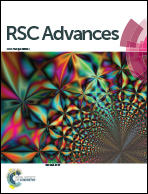Reduction of lead dioxide with oxalic acid to prepare lead oxide as the positive electrode material for lead acid batteries†
Abstract
To achieve efficient and economic recycling of spent lead acid batteries (SLABs), we have invented a route to separately produce positive and negative active materials from the corresponding spent lead pastes based on full separation of the SLABs. This method can avoid the adverse effects of impurities (such as BaSO4) on the recycled positive active material. However, more economic and environment-friendly processes are still needed. This paper reports the room temperature reduction of PbO2 by oxalic acid and subsequent calcination to produce PbO. The results show that the reduction does produce the intermediate H2O2, but it cannot be achieved completely at room temperature, probably due to the PbC2O4 coat on PbO2; the calcination at 450 °C of the PbC2O4 coated PbO2 in air produces fine particles of a sponge-like mixture of α-PbO and Pb3O4, which can be directly used as the positive materials of brand new LABs. After formation, the electrode shows an urchin-like structure composed of many interconnected nano-whiskers, which can still discharge a capacity of 115.2 mA h g−1 after 50 cycles of 100% DOD at 100 mA g−1.



 Please wait while we load your content...
Please wait while we load your content...